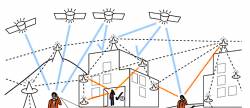
This webinar took place on December 5, 2013. The recorded version of the webinar is no longer available.
Webinar Presentation Slides
This webinar took place on December 5, 2013. The recorded version of the webinar is no longer available.
Webinar Presentation Slides
- Webinar PDF Archive (Registration required)
A fundamental issue facing GNSS users regarding the availability of service involves the presence of harmful interference — not only stray signals but also deliberate jamming. Military GNSS receivers need to be able to operate in unfriendly RF environments and, with increasing frequency, commercial and civil GNSS systems do, too.
Join Inside GNSS on Thursday, December 5, for a FREE web seminar on “The Role of GNSS Antennas in Mitigating Jamming & Interference.”
In 90 minutes of expert presentation, this webinar will provide an overview of signal processing for adaptive antenna systems and discuss key factors involved in integrating beamsteering antennas with GNSS receivers. It will describe the experience and lessons learned from live over-the-air jamming trials and address some practical considerations and the civil outlook going forward.
The webinar will also discuss the use of adaptive antennas for electronic protection. It will present guidelines for the physical antenna array design, including such factors as the effects of aperture size, aperture shape, number of elements, distribution of elements, and individual element characteristics on the adaptive array performance.
Panelists
 Inder (Jiti) Gupta
Inder (Jiti) Gupta
Research Professor
The Ohio State University
Dr. Gupta received his BS (ECE) from Punjab University, India, his MS (EE) from the Indian Institute of Technology, Kanpur; India and his Ph.D. (EE) from The Ohio State University. Since 1979 he has been with the Department of Electrical and Computer Engineering of The Ohio State University. He currently holds the position of a Research professor. He is a Fellow of the IEEE, a Fellow of the Institute of navigation (ION), and an Edmond S. Gillespie Fellow of the Antenna Measurement Techniques Association (AMTA). He is also the recipient of 2007 AMTA Distinguished Achievement Award.
Dr. Gupta’s research interests include radar imaging, EM scattering, antenna/RCS test range technology, adaptive antennas and geolocation techniques. He has worked extensively on adaptive antenna arrays for radio frequency interference suppression and multipath mitigation in communication systems and navigation systems. Dr. Gupta has authored more than 150 journal and conference papers. For the last fifteen years, he has focused on GNSS antennas and antenna electronics.
 Dr. David S. De Lorenzo
Dr. David S. De Lorenzo
Principal Research Engineer at Polaris Wireless and visiting scholar at Stanford University GPS Research Lab
David De Lorenzo is a Principal Research Engineer at Polaris Wireless, co-founder of two successful navigation systems engineering and IP generation consultancies, and a Visiting Scholar at the Stanford University GPS Research Laboratory. Most recently, at Polaris Wireless, Dr. De Lorenzo is leading architecture studies, algorithm development, and field trial validation of multi-sensor GPS, Wi-Fi, and cellular positioning systems for the Polaris E-911, Intelligence/Surveillance, and LBS platforms. Dr. De Lorenzo’s overall research focus is in multi-sensor mobile location, adaptive beamsteering antenna arrays, and navigation systems security and integrity. He received the Ph.D. degree in Aeronautics and Astronautics from Stanford University and previously has worked for Lockheed Martin and for the Intel Corporation. Dr. De Lorenzo has been awarded 16 U.S. patents and has authored or co-authored over 60 papers in peer-reviewed journals, conference proceedings, and industry publications.
Moderator
 Dr. Mark Petovello
Dr. Mark Petovello
University of Calgary
Mark Petovello is a professor in the Department of Geomatics Engineering at the University of Calgary in Alberta, Canada, and a contributing editor for Inside GNSS where he coordinates the column, “GNSS Solutions.” He has been actively involved in many aspects of positioning and navigation since 1997, including GNSS algorithm development, inertial navigation, sensor integration, and software development. He obtained B.Sc. and Ph.D. degrees in geomatics engineering from the University of Calgary.





